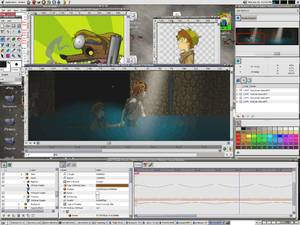Synfig
 | |
|
Synfig on Linux | |
| Original author(s) | Robert Quattlebaum |
|---|---|
| Stable release |
1.0.2
/ October 10, 2015 |
| Written in | C++ (using gtkmm) |
| Operating system | Linux, Mac OS X, Windows |
| Type | Vector graphics editor, computer animation |
| License | GPL |
| Website |
synfig |
Synfig Studio (also known as Synfig) is a free and open source 2D vector graphics and timeline-based computer animation program created by Robert Quattlebaum[1] with additional contributions by Adrian Bentley.
Synfig began as the custom animation platform for Voria Studios (now defunct[2]), and in 2005 was released as free/open source software, under the GNU General Public License.[3]
Features
As a true front-end and back-end application, it is possible to design the animation in the front-end, Synfig Studio, and to render it at a later time with the backend, Synfig Tool, on another (potentially faster) computer without a graphical display connected.
The goal of the developers is to create a program that is capable of producing "feature-film quality animation with fewer people and resources."[4] The program offers an alternative to manual tweening so that the animator doesn't have to draw each and every frame.[5]
The software is capable of simulating soft-shading using curved gradients within an area so that the animator doesn't have to draw shading into every single frame. There is also a wide variety of other real-time effects that can be applied to layers or groups of layers like radial blurs, color tweaks that all are resolution-independent. Other features include the ability to control and animate the width of lines at their individual control points, and the ability to link any related data from one object to another. Synfig also works with High Dynamic Range Imaging.
File formats
Synfig stores its animations in its own XML file format, often compressed with gzip. These files use the filename extension .sif (uncompressed), .sifz (compressed) or .sfg (zip container format). The files store vector graphics data, embed or reference external bitmap images, and also a revision history of the project.
Synfig can render to video formats such as AVI, Theora and MPEG, as well as animated graphics formats such as MNG and GIF. It can also render to a sequence of numbered image files, using formats such as PNG, BMP, PPM and OpenEXR.
From version 0.62.00, Synfig has basic support for SVG import.[6]
From version 0.91 Inkscape can save as .sif file format.
Uses
Since May 2008 (first blog entry the November 1st 2007), a group of Russian volunteers have been trying to make an animation movie project called the Morevna Project using Synfig, based on the folk-tale of Marya Morevna re-invented as a science fiction anime. They have been making regular updates since then on the Morevna project site, including a demo video released on November 10, 2012.[7] Free Software Magazine contained an article on the project.[8]
Name
It was originally called SINFG, a recursive acronym for "SINFG Is Not A Fractal Generator", referring to the software's capability of generating fractal imagery in addition to animation.[9]
See also
References
- ↑ "Interview with Synfig's Robert Quattlebaum".
- ↑ "Voria Studios Closing Letter".
- ↑ "Synfig Open-Source Announcement".
- ↑ "Synfig Studio :: Home".
- ↑ Bowen, Ronda (13 March 2011). "Top 5 Low-Budget and Free Flash Editors". Brighthub.com. Bright Hub Inc. Retrieved 7 February 2015.
- ↑ "Synfig 0.62.00 Release".
- ↑ "Morevnaproject.org".
- ↑ "The Morevna Project: Anime with Synfig and Blender".
- ↑ "Synfig Studio :: History".
External links
| Wikimedia Commons has media related to Synfig. |

